#Petit-Goâve
Explore tagged Tumblr posts
Text
Le MSPP Alerte la Population sur des Cas de Maladie du Charbon à Petit-Goâve
Le Ministère de la Santé Publique et de la Population (MSPP) a récemment alerté la population sur des cas présentant des signes et symptômes de la maladie du charbon dans la localité de Fort Royal, première section communale de Petit-Goâve. Cette alerte, émise le 12 juillet 2024, fait suite à des rapports indiquant que plusieurs personnes ont développé des symptômes après avoir consommé de la…
0 notes
Text
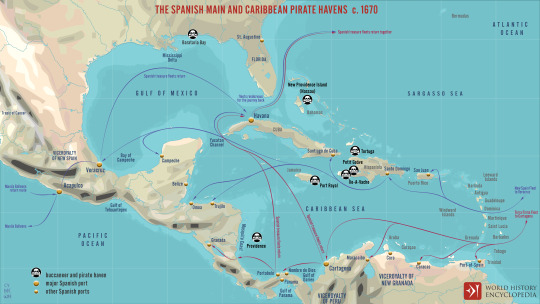
SPANISH MAIN AND CARIBBEAN PIRATE HAVENS c.1670 (x)
« A map illustrating the routes of the Treasure Fleet (the New Spain and the Terra Firma Fleet) alongside the Spanish Main (the parts of the Spanish Empire on the mainland of the Americas with coastlines on the Caribbean Sea and the Gulf of Mexico) and the islands in the Caribbean (Spanish West Indies). It also depicts the most notorious havens of the buccaneers and pirates that prayed on merchant shipping and the flow of Spanish treasure from the region. »
PETIT GOAVE: on the southwest coast of Hispaniola, It attracted buccaneers from the 1670s after the decline of Tortuga and was particularly popular with French pirates and the notorious Dutchman Laurens de Graff, since it was far from the (non-corrupt) French colonial authorities yet close to the Spanish Main. By 1700, the buccaneers had been replaced by outright pirates, and Petit Goâve became a mere footnote in French affairs in the Caribbean.
ILE-A-VACHE: island off the southwest coast of Hispaniola, approx. 50 km², was used by many French pirates and the base to privateer Henry Morgan (c. 1635-1688). NOT really a pirate haven in the 1700s.
TORTUGA: island off the northwest coast of Hispaniola, approx. 60 km², became a haunt of cattle hunters and then a pirate base of significance in the mid-17th century when French buccaneers chose it for its proximity to the major regional shipping routes. The base had the additional advantage that there was plentiful meat from cattle and pigs introduced there by early Spanish settlers, and if necessary, the pirates could retreat to the interior’s mountains.
In 1642, the French authorities on St. Kitts appointed Jean Le Vasseur as the governor of Tortuga, but he built a fortress with 40 cannons and declared his colony independent. For the next decade, Tortuga became the most important buccaneer/pirate haven in the Caribbean. Le Vasseur grew rich from his handsome cut of all pirate business in his mini-state. A Spanish force again tried its luck in 1655, but an English fleet rescued Tortuga, and both French and English settlers were welcomed. The pirates had not gone away, though, and continued to be attracted by the advantages of the base. The French took over again in 1665, but they realised the pirates were an excellent deterrent to the Spanish and so left Tortuga pretty much as it was, concentrating instead on colonising the east side of Hispaniola. The island was repeatedly attacked by French and Spanish forces in the 1670s and so many pirates moved on to Petit Goâve by the close of the century, even if a few pirates remained loyal to Tortuga until piracy was banned there by the French authorities in 1713.
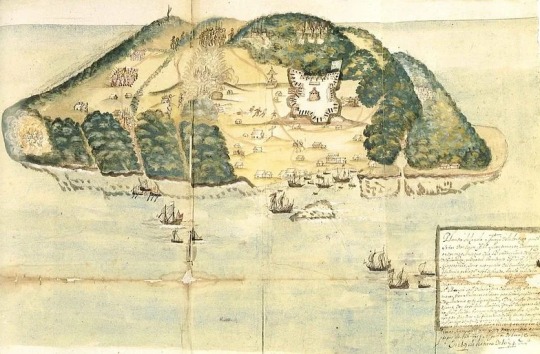
Illustration of the buccaneer and pirate base of Tortuga c. 1600s (x)
PORT ROYAL: on the southeast coast of Jamaica, it was the main port of Jamaica, a British possession from 1655. Known in its early days by its Carib-Spanish name Cayagua ('Water Island') and then anglicized as Cagway, it was given a powerful fortress by the British, but the withdrawal of the Royal Navy left it exposed to Spanish warships. From 1657, Governor Edward D’Oyley, encouraged buccaneers of several nationalities to make the harbour their base and concentrate their plundering on Spanish ships, issuing letters of marque as authority to do so. England’s war with Spain ended in 1660, but many of the buccaneers continued their attacks on legitimate shipping. Subsequent governors were wont to encourage piracy since the presence of many well-armed ships in the harbour significantly lessened the threat from Spain, the Netherlands, and France.
Port Royal became a pirate hotspot in the second half of the 17th century simply because it was so far from the authorities in London and those officials on the island were more pragmatic. Its advantages included a naturally protected harbour that could hold up to 500 ships and a strategic location right in the middle of the Caribbean-Americas shipping routes.
Buccaneers like Sir Henry Morgan, who repeatedly attacked Spanish ships and colonial ports, were based on Jamaica. Morgan was even appointed Lieutenant-governor in 1675. Port Royal became awash with goods and riches, so much so, one contemporary author described it as having more cash than London. By 1680, the haven’s prosperity is evidenced by the presence of over 100 taverns. There were, too, so many gaming houses and brothels that a visiting clergyman described Port Royal as "the Sodom of the New World" (Breverton, 260). This clergyman did not even bother to stay but returned to England on the very same ship on which he had arrived "since the majority of its population consists of pirates, cut-throats, whores and some of the vilest persons in the whole of the world, I felt my permanence there was of no use".
In 1681 the Jamaican authorities finally outlawed piracy, and the pirates moved to other havens such as New Providence. Port Royal was destroyed on 7 June 1692 by a combination of earthquake and tsunami. Several thousand people were killed in the disaster. Although half of Port Royal slipped forever into the ocean, the spot would eventually return to prominence as a place where several notorious pirates were hanged and operate as a British naval base.
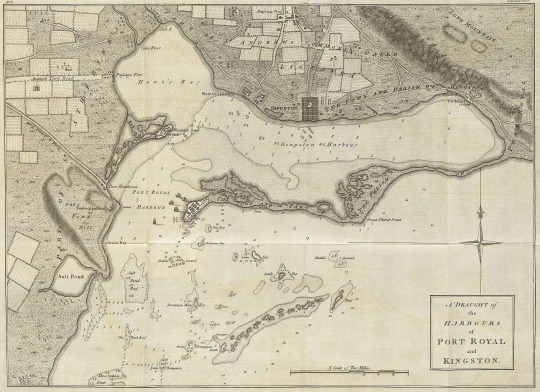
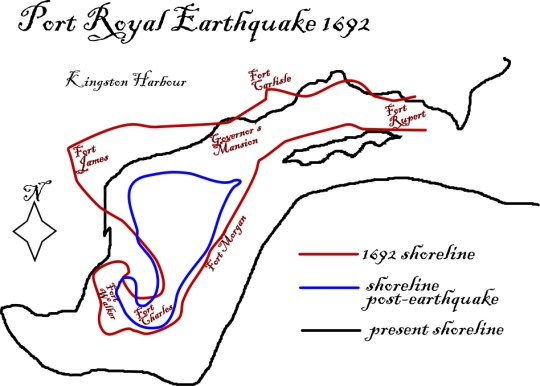
Port Royal and Kingston Harbour, 1774. Port Royal is the town at the tip of the peninsula in the center of the map / Shoreline changes in the 1692 Port Royal earthquake (x)
NASSAU: main city of New Providence Island, it took over from Tortuga as the region's main base for pirates. The small island reached its peak as a pirate haven from the 1670s, first for buccaneers chased out of Jamaican waters and then, from around 1713, for pirates who attacked anybody they fancied regardless of nationality. There were good harbours, and plenty of freshwater, meat, timber, and fruit on the island. Called Nassau from 1695. Such pirates as Blackbeard, Jack Rackham (d. 1720), Benjamin Hornigold (d. 1719), and Samuel Bellamy (d. 1717) used the island as a base. In total, there were some 600 pirates sailing from Nassau who raided shipping and ports from the Caribbean to Maine. From 1718, Governor Woodes Rogers (1679-1732), a staunch enemy of piracy, rebuilt the fortress and stationed cannons at strategic points in the harbour to ward off any pirates thinking of returning. The Bahamas suffered another period of neglect under Rogers’ successor and became a minor pirate haven again until full colonial control was re-established.
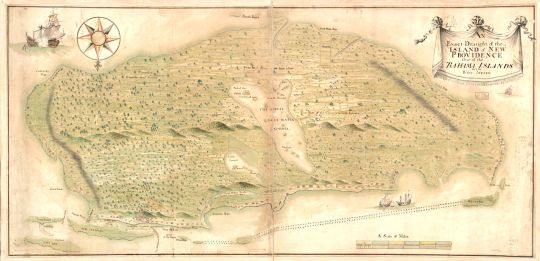
ISLAND OF NEW PROVIDENCE (circa 1700-1750) (x)
PROVIDENCE: island off the coast of central america, had a good harbour, which was easily defended from its high cliffs. It was first settled by the English from 1630. As elsewhere, piracy was encouraged since it brought trade and a means of defence against Spanish attacks. Indeed, the islands came under Spanish control from 1641 to 1666, and it was not fully out of Spanish hands until Sir Henry Morgan used Providence as a base for his attacks on Panama in 1670 and 1671. The principal trading port had several small forts around the harbor and at the bay's entrance. There were about fourteen forts in all. It is possible pirates inhabited the island a while after that (nothing on its history in the 1700s), but when privateer Louis Michel Aury settled there in 1818, he found the island populated by white English-speaking Protestants and their slaves.

Drawing of the fortress of privateer Louis Michel Aury by Louis Perou de Lacroix (1821) (x)
12 notes
·
View notes
Text
Un bateau fait naufrage au large de Petit-Goâve, plusieurs passagers portés disparus
Un bateau a fait naufrage dans la nuit du vendredi 13 au samedi 14 décembre au large de Petit-Goâve. Une vingtaine de passagers ont été secourus tandis que plusieurs autres sont portés disparus. En partance de Port-au-Prince à destination de Miragoâne, dans le département des Nippes, le bateau baptisé “La Sicilia” a fait naufrage dans la nuit du vendredi 13 au samedi 14 décembre, au large de…
0 notes
Text
Le MARNDR alerte sur une maladie ressemblant à celle du Charbon, découverte en Haïti
Le ministère de l’Agriculture signale la population, les éleveurs de bœuf, cabris et moutons en particulier de la présence d’une maladie ressemblant à celle du charbon découverte à Petit-Goâve et dans plusieurs localités dans le département du Sud et Sud Est du pays. Face à cette maladie infectieuse qui pourrait causer la mort subite chez les animaux et des boutons, des problèmes respiratoires et…
#bœuf#cabris#charbon#Haiti#maladie#MARNDR#Ministère de l&039;Agriculture#Petit-Gôave#Santé#Sud#Sud-Est
0 notes
Text
El hambre amenaza con matar a 500 presos de la prisión civil de Petit-Goâve
Haiti Hay una necesidad urgente de alimentos para la prisión civil de Petit-Goâve. 500 prisioneros corren el riesgo de morir de hambre. El comisionado gubernamental de la comuna y el director de la prisión lanzaron un SOS al Estado haitiano y a las organizaciones de derechos humanos, en la mañana del martes 28 de mayo de 2024. Quieren a su vez tener alimentos para los detenidos para evitar lo…

View On WordPress
0 notes
Text

Haiti: Journey to the heart of the anti-Ariel Henry mobilization, part 1
By Catherine Charlemagne
In Haiti, notably in Hinche, Cap-Haïtien, Ouanaminthe, Miragoâne, Jérémie, Gonaïves, Cayes, Petit-Goâve, Mirebalais, not to mention Port-au-Prince and Pétion-Ville, it’s indisputable that the authorities are not really in control of the country.
Ariel Henry can always argue that he did not leave power on February 7, as requested by the opposition and a large part of the population. Nevertheless, the evidence is there: he no longer has authority over anyone, perhaps only over his police force, who kill for him and brutalize street children.
5 notes
·
View notes
Text

A view from Olivier Coquelin's hotel, Le Relais de L'Empereur in Petit-Goâve, Haiti in 1981.
0 notes
Photo

Shades of blue. @samueldameus #Haiti
22 notes
·
View notes
Text
Nearly 85% of the Haitian people live on $5.30 a day or less. Severe malnutrition among young children is rampant, and the streets are overflowing with uncollected garbage. Potable water is scarce along with medical care — cholera, which is often spread through contaminated water, has broken out, with hundreds of cases reported in the last few weeks.
Access to education is spotty. The state has not fed or given water to prisoners since the beginning of the year, leading radio stations to run feed-the-prisoner campaigns; Haitian prisoners are dying from malnutrition.
It has been clear for months that acting Prime Minister/President Ariel Henry — appointed 16 months ago by the U.S. with the blessing of the Core Group — has not been able to control the rising, militant, hungry anger of the Haitian masses. The Core Group consists of the ambassadors of Canada, France, Brazil, Germany and Spain, along with representatives of the U.N. and the Organization of American States (OAS).
Since the beginning of August, hundreds of thousands of Haitians have taken to the streets in increasingly militant demonstrations to express their total rejection of Henry’s government and U.S. imperialism.
On Oct. 10, huge demonstrations rose up in Port-au-Prince, Petit-Goâve, Jacmel, l’Île de la Gonâve, Mirebalais, Lascahobas, Cap-Haïtien and Gonaïves. In Cap-Haïtien, a massive demonstration was attacked by cops firing live rounds. One demonstrator was shot dead; in reaction the crowd attacked and ransacked businesses, including a branch of Unibank, one of two major Haitian banks, which was set ablaze.
Since their puppet Ariel has proven to be hugely unpopular, the U.S. has apparently decided to try someone else. A Disaster Assistance Response Team is currently in Port-au-Prince. DART teams generally consist of “experts” from the political arms of U.S. imperialism, who assess “needs” and organize the delivery of “aid.”
2K notes
·
View notes
Text
Décès de l'ancien bâtonnier de l'ordre des Avocats de Petit-Goâve, Me Justin O. Fièvre
Décès de l'ancien bâtonnier de l'ordre des Avocats de Petit-Goâve, Me Justin O. Fièvre.- #Juno7 #J7Oct2021
Décès de l’ancien bâtonnier de l’ordre des Avocats de Petit-Goâve, Me Justin Oreste Fièvre à l’âge de 76 ans Le plus ancien Avocat du Barreau de Petit-Goave, Me Justin Oreste Fièvre a rendu l’âme ce jeudi 14 octobre, à l’hôpital Nôtre Dame de Petit-Goâve suite à un malaise, à l’âge de 76 ans. Me Justin Oreste Fièvre était bâtonnier de l’ordre des avocats de Petit-Goâve depuis plus de 8 ans. Il…

View On WordPress
0 notes
Text
Transfert des Détenus de la Prison Civile de Carrefour vers Petit-Goâve en Raison de la Violence des Gangs
Les détenus de la prison civile de Carrefour ont été transférés ce mercredi au centre d’incarcération de Petit-Goâve. Cette décision a été prise en raison de la montée en flèche de la violence des gangs qui contrôlent presque entièrement la commune de Carrefour, selon une source policière anonyme. La violence des gangs à Carrefour a atteint un niveau critique, rendant impossible la sécurité des…
#centre d’incarcération Petit-Goâve#conditions transfert détenus.#décision autorité pénitentiaire#sécurité prison Haïti#transfert détenus prison Carrefour#violence des gangs Haïti
0 notes
Text

Petit-Goâve, Haiti 🇭🇹 via Faces Of Haiti
#haiti#ayiti#haitian#caribbean#ayisyen#west indian#west indies#tropical#blackout#island#photography#trending#islandlife#beach#melanin#island aesthetic
75 notes
·
View notes
Text
Eventuelle épidémie de charbon : le MSPP rassure la population et indique des consignes à suivre
Le Ministère de la Santé Publique a assuré qu’il prend acte des cas de maladie présentant des signes et symptômes liés au charbon, recensés à Petit-Goâve, environ deux semaines de cela. Il a indiqué qu’une investigation épidémiologique est en train d’être menée pour identifier la source de l’infection, évaluer l’ampleur et prendre des mesures appropriées. Depuis le 12 juillet dernier, une…
0 notes
Text
Alerte sanitaire à Petit-Goâve : suspicion de la maladie du Charbon
Le 12 juillet 2024, le Ministère de la Santé Publique et de la Population (MSPP) a émis une alerte suite à des cas suspects d’anthrax dans la localité de Fort Royal, située dans la première section communale de Petit-Goâve. L’alerte fait suite à un rapport du Western Health Service indiquant que plusieurs personnes ont consommé de la viande provenant d’un animal mort subitement. Une enquête…
0 notes